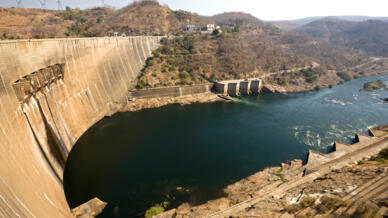
Zambia will start power cuts from Thursday 15 December which are expected to last six hours at a stretch.
Energy minister, Peter Kapala, told the Zambian Parliament that it may only affect residential areas.
Zimbabwe, on the other hand, is already facing 19 hours load shedding daily with devastating effects on all aspects of life in the country. Electricity is turned back on between approximately midnight and 5 AM.
“Kariba generates almost half of our power needs, which is why a reduction in its generation capacity immediately registers throughout our economy and in our lives,” wrote Zimbabwe’s President Emmerson Mnangagwa in his weekly column in the State-controlled Sunday Mail newspaper.
Hospitals are sometimes left without water because pumps are inoperative.
Small businesses have been badly hit. Charles Svidzi, a 59-year-old barber, told AFP he was forced to close his shop as he depends on electric hair clippers and there are no customers at night.
Climate change
Kariba’s water level has been decreasing steadily because of droughts and low inflows from the Zambezi River and its tributaries.
Kariba Dam is the largest man-made one in the world, providing the bulk of electricity consumed in both Zambia and Zimbabwe.
The level of usable water in Kariba, tapped by both Zambia and Zimbabwe, stood at 2.68 per cent on 7 December 2022, according to the Zambezi River Authority (ZRA), which manages water supply for the two countries.
ZRA is responsible for the allocation of water used by Zimbabwe’s Kariba South and Zambia’s Kariba North Power Stations.
On 25 November, ZRA wrote to the Zimbabwe Power Company that the Kariba South hydropower station had used more than its 2022 water allocation.
“The Zambezi River Authority is left with no choice but to firmly guide that … generation activities at the South Bank Power Station are wholly suspended henceforth until January 2023 when a further review of the substantive hydrological outlook at Kariba will be undertaken,” the letter read.
Zimbabwe’s Energy Minister, Soda Zhemu, said that the power plant would not shut down completely but would “continue to generate but at a reduced capacity”.
The government said it will increase power imports from South Africa, Zambia and Mozambique.
Reliance on coal
Harare announced that it will increase its coal production and has decided “to rehabilitate Hwange power station with around US $310 million”.
“This should teach us a lesson; we cannot be sentimental about coal while our industries die from power shortages, and when no support to clean energy transition is coming from those most to blame for destroying the global climate.
“We have abundant coal; it must be harnessed to meet our energy needs,” said President Mnangagwa.
He also announced plans to “step up investments”, with the private sector, in solar energy.
“We have enough sunshine; we have enough land for solar farms,” he added.
Power cuts in Zimbabwe are due to last until, at least, early January 2023 whilst the Zambian government said they would last “until the water levels inprove”.


